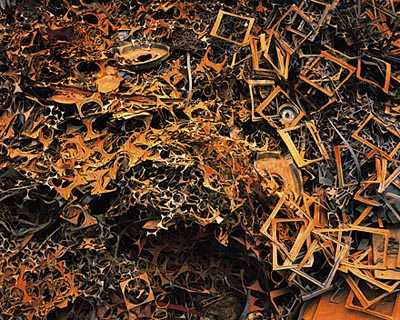| previous | 4 January 2006 | next
One of my New Year’s resolutions is to actually finish a few of the books I’ve started. My first success is Calvin Tompkins’ Off the Wall. Though I hadn’t read it before, it felt comfortably familiar. In fact, I’m sure that a lot of the sensibilities expressed in Tomkins’ book informed my professors in college - most of them might have read it in the early 80’s so it would have been fresh in their minds in the late-80’s when I was a student. In building Rauschenberg’s myth, it clearly articulated many of the ideas at the heart of the process-oriented program in which I was enrolled - particularly the attitude that art is an experiment that yields unpredictable results, rather than the exposition of predetermined content. As Tompkins finds Rauschenberg’s career to be a useful lens through which to summarize the changes in American art in the second half of the 20th century, I am finding ‘Off the Wall’ might be useful for linking together some themes that are showing up in my own thinking. If a contemporary artist were to consciously assert his place in history [this appears to be a hallmark of current practice] what better way than to make representations of trash? Edward Burtynsky's Urban Mines are a good example, both embodying the concept that all things visual can be embraced by Art-with-a-capital-A, and doing so in a masterful, seductive way.
Better yet, why not use trash as the medium? Consider then, Bruce Sterling, in Shaping Things, [Yay! Another book I've finished!] mentions:
Indeed, soup cans in landfills might last longer and be more telling of the accomplishments of the 20th century. In Ken Johnson’s NYT review of ‘Monuments for the USA’
Tomkins discusses at length how Rauschenberg's embrace of garbage extended what Schwitters and Duchamp had done, both as a medium and as subject, equal to other media and subjects. Junk is just a special case of stuff, as are traditional artist's materials. So, how does one extend Rauschenberg's embrace? Perhaps to include the disposable objects that will be made of grey goo in FabLabs, and once they've outlived their usefulness, will revert back to re-usable grey goo, leaving zero environmental footprint? And then perhaps to include the virtual models that defined those disposable objects? Coincidentally, Sterling writes at length about these future products, and how they will have a deep virtual aspect. He calls them 'spimes' and elaborates:
White kind of spimes would Rauschenberg or Duchamp create? Until FabLabs are widespread, a good place to explore the aesthetic potential of spimes might be in their natural habitat, in simulations. A couple of weeks ago a friend started picking my brain about Second Life – a virtual community that I’d heard of in passing. Unlike a multi-user game, it has no particular objective. It’s simply a place where one can create an identity, interact with others, and to a limited degree modify the environment. For example, Cory Doctorow, a sci-fi writer and contributor to bOINGbOING, recently did a virtual book-signing on 2L - his custom avatar was made to approximate his real-world appearance, he discussed his latest novel, and a virtual instance of the book was created in 2L [in fact there were several designs proposed for the 'book' object.] My friend [who in 2L goes by the name Albedo Ixchel] and I discussed the possibility of creating an art gallery in 2L - one that actually takes advantage of the properties of things that are native to 2L, rather than simply putting up scans of 'real-world' images. This means objects that might have properties, or behaviors similar to works like Rauschenberg's 'Revolver' pieces, or Calder's mobiles. Bruce Sterling writes about the mobiles in a way that I think could clearly translate to 2L objects:
In addition to the kinds of projects that might be *in* the gallery, we've talked a little about the architecture of the gallery as well. On one end of the spectrum, we've talked about something like Duchamps 'Valise,' while on the other end something like a Borges-ian library of all possible books. Perhaps, like Rauschenberg's combines, or the accumulation of objects in Katamari Damacy, it will just be a pile of objects sitting in a vacant lot. |
